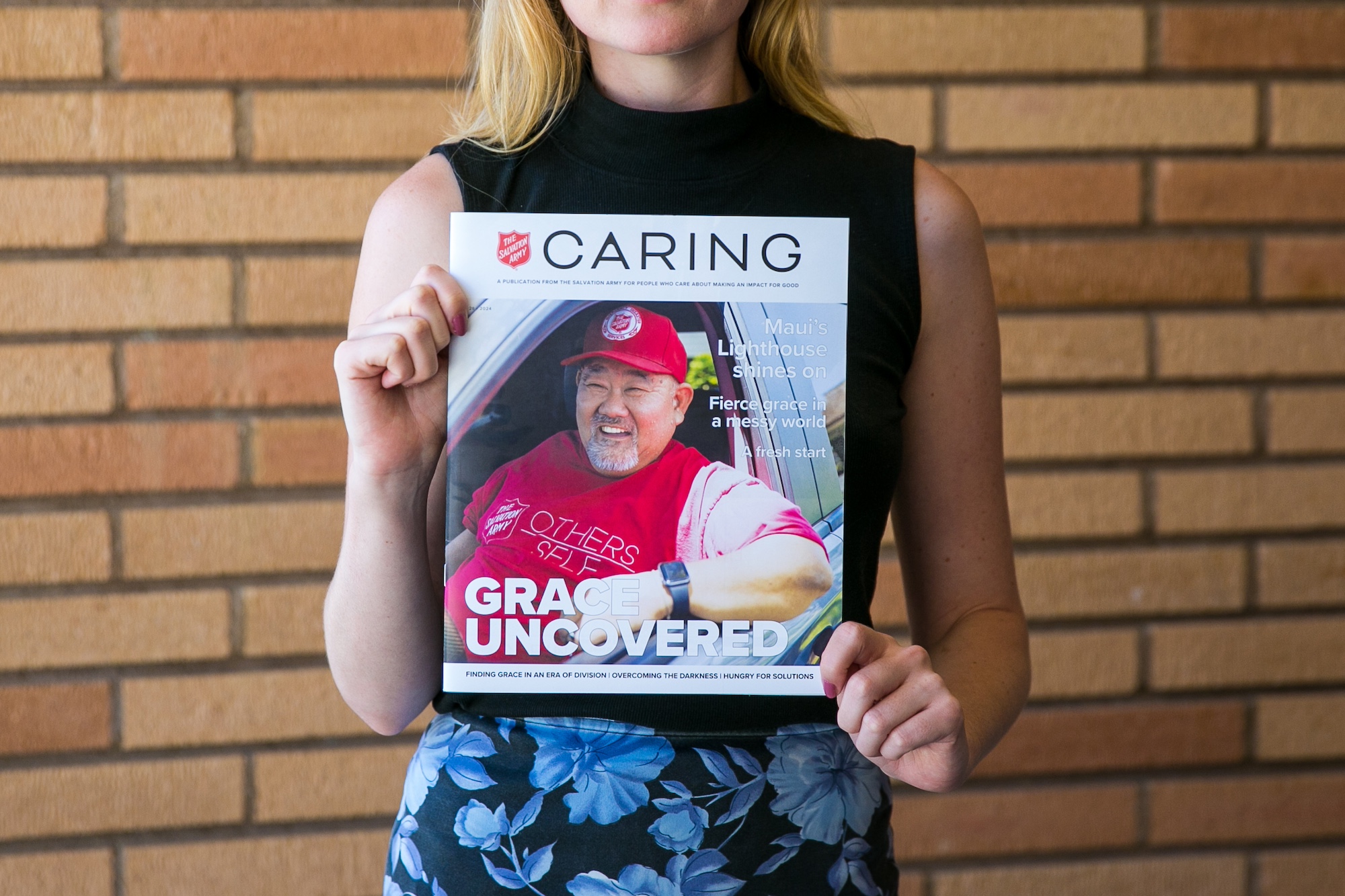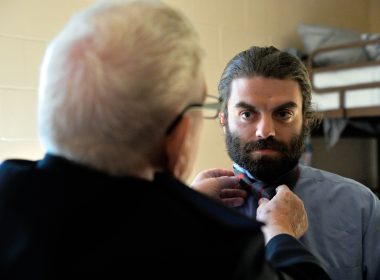Doing the Most Good in Del Oro
Major Eda Hokom meets one of 7,000 Harley Davidson riders who dropped off toys at the State Capitol during last year’s holiday Toy Run. |
When Major Alfred Wells established Sacramento’s first corps in 1884, it’s unlikely that he imagined the impact it would have more than 120 years later.
Today, with its headquarters in Sacramento, the Del Oro Division’s mission and ministry meets needs “close to home”—and across the state.
‘B’ Street Center
Not far from DHQ, the ‘B’ Street facility provides assistance through its shelter, family services, and warehouse: typical Army ministries, carried out in typical caring, compassionate Army style.
While the shelter operates 24 hours, seven days a week, housing up to 60 men and 52 women, the statistics don’t tell much of the story. Larry Dayton, program coordinator, notes that most of the clients are between 40-55, and some are older yet. “We had one man who was over 91 and had been in movies with Will Rogers,” he recalls. “Another, a Tuskegee airman, was 89.”
“Ours is the best shelter in town,” says Divisional Secretary for Program Capt. John Brackenbury. “Clients don’t fear for their lives here. Our staff is incredible—the most loving and caring that I’ve met.”
In April, a new program started in conjunction with three area healthcare providers: Sutter, UC Davis, and Catholic Health Care. When homeless patients needing further medical evaluation are discharged from the hospital, they are provided a bed and case management at the Army’s shelter; a nurse visits the shelter to stay in touch and monitor the patient’s progress. It’s an innovative program; one that meets vital needs in a caring manner.
Cruz Guzman, family services director, notes that around 500 families and individuals are served each month, receiving help with rent, utilities, and food. Food and supplies are housed in a 15,000 square foot warehouse—the site of Governor Arnold Schwarzenegger’s recent visit when Army provisions were being staged for delivery to Hurricane Katrina survivors.
Alhambra Complex
Located in Sacramento’s tree-lined Oak Park Community, home to the lowest socioeconomic group in the county, the Sacramento Citadel Corps, Ray Robinson Oak Park Community Center, and Little Lambs Day Care all provide programs that meet the unique needs of the neighborhood.
Laura Van Ness, Little Lambs director, explains that the preschool program is funded by the California Department of Education and is free to residents of the community. She notes that their focus is on school age readiness, language and literacy. Her enthusiasm is evident. “This program fits a big need for families and extended families; we’re here not just for one child, but for all the children. We have brothers, sisters, cousins, and little aunts and uncles here. I see the feeling of hope this program gives parents for the future of their children.”
For older youth, the Ray Robinson Oak Park Community Center provides a wealth of basketball activities as well as a before and after school program for 6-12 year-olds. Open from 7-8 a.m. and 3-5:45 p.m., the state-licensed center provides a cheerful place for youth to do homework and receive individualized tutoring. Among their resources are 12 laptop computers from the Beaumont Foundation, which enable students to research and write reports—something that would not be possible at home.
Captains Osei and Lynn Stewart, corps officers, have a full slate of programs, from youth activities to church meetings. Creative ministries provide opportunities for kids to learn guitar and participate in drama, rap, mime, and gospel magic.
Reaching out to the neighborhood is a priority for them. “One of our challenges is to link the community center with the corps,” he says. “We have 300 families a week coming through the center. None come to the corps.” They have already started addressing that concern: monthly Sunday Night Live meetings at the corps provide a ‘bridge,’ and plans are underway for a door-to-door community outreach. Recently, Stewart notes, 12 homeless people who congregate across the street from the corps attended the Sunday night meeting.
Lodi
The banner above the new Hope Harbor Shelter reads “The Dream is Alive!” and standing outside, the first thing you notice is the music: it’s a praise hymn. “We have a culture of worship and praise here,” says Major Frank Severs. He and his wife, Major Susan Severs, serve as Lodi corps officers. He explains that Lodi had a dream to relocate the shelter and add space for women and children; that dream has now come true. The sparkling clean facility provides emergency and transitional shelter for men, women and children for up to 56 nights a year; meals are prepared in a large, well-equipped kitchen.
Over on Lockeford Street, you can’t miss the Lodi Corps: a huge marquee reads “Center of Hope” and lists SA programs—Celebrate Recovery: Solid Rock Café 8 p.m.; Friday nights 6 p.m.—Christian solutions for hurts, hang-ups, habits.
Next to the main entrance is another sign: Lodi Memorial Hospital—Salvation Army Clinic. Here, two days a week, free medical services are provided to those without insurance; last year, over 1,500 were assisted. Elsewhere inside the building is a huge warehouse filled with groceries. “We’re the North San Joaquin Valley’s official food bank,” says Severs, who notes that 200 tons of food move through there each year.
Clearly, the Army in Lodi has discovered holistic ministry.
Stockton
A short hop down the freeway from Lodi, the Stockton Corps faces a variety of challenges—some more extreme than others, according to Corps Officers Captains Kit and Pat Wetter. In the last few years, he explains, two people were shot and killed outside the corps; prostitutes used to congregate on the sidewalk outside. “You can’t have that!” he says. “It was keeping families from attending the corps.” Working with the local police, some of those problems have been remedied.
Sensitivity to the needs of the community has led to programs that change lives: a weekly support group for at-risk youth is attended by 18-20 boys and girls who have been sexually, physically, or emotionally abused; a one-year certification course, in Spanish, is held at the corps for construction workers. Meeting four nights a week, 25 are currently enrolled. “We’ve teamed up,” said Wetter. “They help us with maintaining our building, and they will be getting certified.” In addition to a host of teen programs, 25-30 Home League seniors meet weekly—and have found a ministry in knitting and crocheting, providing hats for children receiving treatment for cancer, and shrouds for stillborn infants in the county hospital.
Oakland Chinatown
Squeezed into a 7,500 square foot building, the Oakland Chinatown Corps, under Capt. Grace Tse’s leadership, conducts a vibrant ministry to seniors and youth, providing a sense of community and caring. Up to 150 attend monthly field trips; many seniors participate in citizenship and English classes. Youth are also a priority for Tse. Friday nights will find 20-30 youth, along with Grace, at the youth fellowship—often staying up until midnight. Laying the groundwork for future generations, she conducts a two-year leadership class for youth. In the summer, the corps virtually turns into a summer camp for eight weeks, offering fun for kids who would otherwise be hanging out at home or on street corners. Each summer, Major Candi Frizzell, divisional women’s ministries secretary, spends a week participating in the day camp and raves about its impact on the young people. Fortunately, the division is in the process of purchasing a 16,000 square foot building nearby to house the Chinatown Corps, and provide ample space for its programs.
Garden Center complex
Over at the Oakland Garden Center complex, a 65-bed emergency and transitional shelter is available for the homeless; child care, under the direction of Natalia De Ocera, is offered for working parents.
The complex, under the administration of Alameda County Coordinator Major George Rocheleau and Oakland Center Executive Director and County Special Services Director Major Dawn Rocheleau, is located on the site of the former Booth Memorial Home and Hospital.
Captains Ariel and Veronica Ochoa, Garden Center corps officers, have initiated worship services in both English and Spanish, with Spanish services lasting up to three hours. “We dance and sing and worship,” said Captain Veronica, who added that two years ago, they got a worship leader who had a desire to teach the kids to play music. Now, the youth—all between five and 17 years—lead worship, with two on drums, two on keyboard, one on bass, one guitar, and one female vocalist.
Concord Corps
Programs for youth fill the schedule of the Concord Corps, under the leadership of Corps Officers Majors Clay and Pam Gardner. The corps is the site of Del Oro’s proposed Kroc Center. On a recent Tuesday, 24 kids enjoyed the after school program, overseen by credentialed schoolteachers. A snack, homework, and educational games were all part of the afternoon. Many of the students have raised their coursework from being one to two levels below to being at the appropriate level. The youth also enjoy Sunbeams and Adventure Corps activities. In addition, the corps operates a food bank, with 260-300 families each month receiving food boxes. The Gardners and Captain Suzanne Mondell, assisted by the Concord Corps’ band and songsters, provide inspirational Sunday services every week attracting people from the surrounding community.
Antioch
For young people in the Antioch Corps’ neighborhood, The Salvation Army provides a safe haven—and a lifeline to a positive future. Captain Jacqueline Vaughnes-Smith, corps officer, is clear about her concerns for the youth and her expectations for their future. Many of the parents, she said, are on drugs or “just have a schizophrenic lifestyle.”
An after school program attended by 20-25 students provides a chance for the kids to do their homework and receive help in reading. “It’s so important for them to be fluent in reading and writing,” she said. “And the kids enjoy it because it is a safe place; it provides consistency. About half of these kids can’t count on one day being the same as the next.”
Building a church that cares for its families is of utmost concern to her. “There is a tremendous amount of drugs, child abuse, and neglect here,” said Vaughnes-Smith. “I want to teach these young people about life, that they have to get a job, take care of their children, and that they can’t steal. Many of them have never finished anything they started.”
Sundays are devoted to the youth. About one third of those attending services are adults, and two thirds are children. The day starts with breakfast at 10 a.m., and includes Bible school from 11:30 to 1 p.m., Scouting at 2 and worship at 4 p.m. It ends with dinner from 6 to 7 p.m. “I know that on Sunday they’ll have real food; it may be the only time that week.”
Friday night is set aside for prayer—usually for five hours—often ending at 1 or 2 a.m. “We spend a lot of time in prayer,” noted Jacqueline. “Seventy-five percent of our kids have been sexually molested. If I didn’t have Jesus to tell me what to do, it would be impossible.”
Before becoming a Salvation Army officer, Vaughnes-Smith spent 20 years working as a buyer for Macy’s, where she had a $12 million budget and took business trips to New York, Hong Kong, Japan, and other cities; she admits officership is light years away from her former life. And when she talks about the Army’s ministry, you know she wouldn’t have it any other way.











